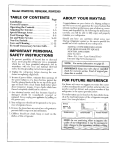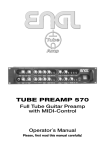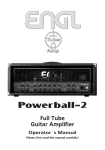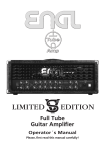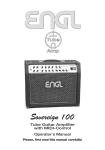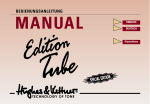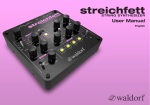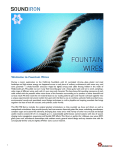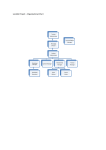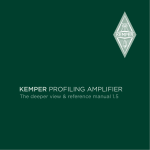Download ENGL Raider 100 E344
Transcript
RAIDER 100 Tube Guitar Amplifier Operator´s Manual Please, first read this manual carefully! Tube Amp Technology Table of Contents Introduction Features and Functionality at a Glance Contents Front Panel Features: Input; Channel 1 Control Features Power Amp section: Presence, Depth Punch, P.T.M. Display Channel 2 Control Features, Mid Boost Power Amp section: Master A/B Channel selection, Hi Gain, FX Loop Stand By, Power page: 4 4, 5 6 6-8 9 10 10 - 12 12 13 Rear Panel Features: Mains, Mains Fuse S.A.C. Port for Z-9, Footswitch Ports Noise Gate: Threshold Level Main FX Loop: Send, Return, and Balance Serial FX Loop: Send, Return Poweramp Output 4, 8 16 Ohms Poweramp Output: speaker options 13 14, 15 15, 16 16 16, 17 17 17, 18 Handling and Care Troubleshooting Important note concerning the cooling fans Technical Data, Detailed Specifications and Ratings Tube Map, Tube Exchange Service Remote Control Options Wiring of Principal Connectors Front Panel Diagrams for Noting Settings Configuration table for Z-9 settings 19 20, 21 21 22 23 24 24 25 26 CAUTION! Please read and heed the following: You'll find an ancillary pamphlet accompanying this owner's manual entitled Instructions for the Prevention of Fire, Electrical Shock and Injury. Be sure to read it before you plug in and power up the amp! Note: Technical specifications are subject to change without notice. 3 Congratulations, ENGL Amp user! The ENGL Raider is one mean machine of a tubedriven guitar amplifier, engineered to inspire you and enthuse your audience. Alongside to-die-for tone, it puts at your fingertips everything you need to tap your creative potential and make your musical message heard and felt! When yours truly, a humble ENGL amp designer by profession, developed the ENGL Raider 100 amp, two goals loomed large in my mind. I aimed to pair tonal perfection with useful features that make sound (pun intended) sense in the real world. Out came a new type of design – a nifty combination of two primary channels 1 and 2, each with different gain structures, and two gain stages. That adds up to four different basic sounds ranging from clean to hi gain lead. Best of all, you can dial in just about any flavor of crunch in between, quickly and easily. To broaden the tonal palette and afford you even greater sound-sculpting flexibility, I endowed the Raider's preamp section with a fresh, new Mid Boost button. Have fun mixing and matching its two settings with any of the four gain stages. With so many options to choose from on the fly, you enjoy instant access to painstakingly tuned, tonally balanced sounds that will serve you well for many styles and playing techniques. Lead sounds with a mighty midrange punch, lean-and-mean rhythm guitar tones, or heavy-duty low end for power chord riffing – you'll find your amp delivers all this and a lot more. And Channel 1 sports innovative brightness boosting circuits designed to accentuate this channel's tonal nuances. Here's how this works: One Bright button affects both of Channel 1's Lo and Hi Gain stages, and another special Clean Bright button affects Channel 1's Lo Gain stage only. Engage it to conjure sparkling clean sounds. On top of this, you get a button that lets you determine if the two power amp voicing knobs Presence and Depth Punch shape the power amp's frequency response for Channel 1. The alternative is to have a precision-tuned, hardwired EQ filtering circuit shape the power amp's response when Channel 1 is active. A/B Master switching is a powerful option that has proven its merits in countless ENGL amps (it was featured in E920 power amps since the late '80s and in the legendary SAVAGE 120 head since '93!). Your Raider Combo also sports two effect loops and a high quality spring reverb system to round out its arsenal of sound-shaping tools. The tonal palette ranges from vintage clean to classic grind, and from creamy rock lead tone with thick, lush tube overdrive to the kind of massive hi-gain lead sound it takes to cut through in appropriate playing situations. And there's more: This amp sports our Serial Amp Control Port, or S.A.C. Port for short. Plug an ENGL Z-9 Custom Foot Controller into to it and get hip to some very convenient remote control options. This footboard lets you activate the two channels in combination with the Hi Gain option and Master A/B switching directly simply by tapping its four footswitches. And that affords you instant access to four sound variations at four different volume levels. In addition, the amp comes with three stereo jacks designed to accept dual footswitches like the ENGL Z-4 or a MIDI switching system (e.g. ENGL Z-11) for selecting the channels and other crucial Amp features. The exterior's compelling visuals certainly match the interior's impressive appointments. This amp's elegant and stylish look is sure to turn heads wherever you play. 4 Your ENGL Raider 100 Amp puts at your disposal: 1. a logical control feature array, utmost ease of use and remarkably intuitive handling; 2. Top-drawer sound-shaping options and remarkable versatility: You can combine two channels offering two gain stages each with different midrange voicings for each of these four gain stages. 3. A broad tonal palette: Surgically precise sound-sculpting functions are at your fingertips, and a tap of your foot on the conveniently compact footboard gives you some very powerful remote control options. 4. Four first-rate fundamental sounds in glorious all-tube tone: Channel 1 Lo Gain takes you from clean to a touch of mean. Channel 1 Hi Gain adds some grit to the mill for sweet crunch tones with a healthy helping of preamp overdrive. Channel 2 Lo Gain takes you deeper into the saturation zone with plenty of headroom to spare. Channel 2 Hi Gain offers oodles of gain potential for creamy, singing lead tone. 5. Even more tone-tweaking power courtesy of Channel 1's Dual Bright button, a feature designed to help you precision-tune those crucial top-end frequencies. If you wish, you can use an extra tone-shaping tool to activate the power amp EQ knobs to voice Channel 1's response or fall back on a power amp EQ preset. 6. further tone-tuning options such as an onboard reverb system featuring dedicated controls for each of the two main channels and a long Reverb spring that conjures lush, deep and warm reverb, as well as two effect loops that let you factor multi-effect processors into the sonic equation; 7. an ultra-advanced tone-generating machine that will give you years of playing pleasure and value to boot. Features and Functionality at a Glance -> Two basic channels: Channel 1 and Channel 2 with with separate Gain and Volume knobs. -> Two Gain options for the each channel: Hi Gain let you activate different gain settings for Channel 1 and Channel 2, thereby extending the number of potential sounds to four. -> Two voicing sections specially tuned for each channel: One three-band EQ for Channel 1 Clean and Crunch modes and one three-band EQ for Channels 2 Lead and Hi Gain Lead modes. The Dual Bright function (2 Bright buttons) is a very special feature that lets you tweak Channel 1's high-end response in both Lo Gain und Hi Gain modes. -> Large spring reverb for very natural-sounding reverb, with separate knobs for the two main channels. -> Two FX loops, a switchable and adjustable Main FX Loop and a Serial FX Loop that is hardwired into the signal path. You can control the Main FX Loop remotely via a footswitch and use this circuit as a hardware bypass for connected FX. -> Two power amp Master knobs. You can footswitch these knobs to activate two different power amp volume settings on the fly without twisting a knob. 5 -> The optional Z-9 Custom Footswitch. It lets you select combinations of channels and the two gain stages directly and control two sound-shaping features of your choice. Three ¼” stereo jack plugs accept three dual footswitches that let you control remotely the two channels, the two gain stages, Mid-Boost, Master A/B, FX Loop, and Reverb. -> A Noise Gate for Channel 2. Activate it to suppress excessive noise at very high gain settings. Among the hallmarks of this fine amp are painstaking workmanship and finishing as well as rigorously tested and carefully selected quality components. You'll find guidelines on care and maintenance of tube amps on page 19. Under the heading Tips from the designer, you'll come across practical tips on the aforementioned features throughout the manual. All critical information concerning the operation of this amp is preceded by "NOTE", "CAUTION", "Read and heed" or some other eye-catching comment. We're calling your attention to these remarks for reasons of safety or other compelling motives, so please give them due consideration. Everyone at ENGL is confident that the Raider tube amp's extraordinary versatility and outstanding features are sure to delight you: Simply plug in, play and be inspired by the tone of your ENGL amp! A few words of wisdom from the designer: Though this amplifier is relatively easy to handle and you're probably raring to give it a go, I recommend that you read the owner's manual thoroughly before you power it up. It is equipped with several safety features that require further explanation to prevent malfunctions. Contents: 1. ENGL Raider 100 Tube Combo Amp E344 (1x12"speaker) 2. mains cord; 3. this manual; 4. a pamphlet entitled Instructions for the Prevention of Fire, Electrical Shock and Injury. Front Panel Features At the back of the manual, you'll find fold-out diagrams of the front and rear panels. As you're reading the descriptions of the amp's features, you'll gain a better understanding of the topic of discussion if you unfold and refer to them as we go! 1 Input ¼" unbalanced input jack. Plug your guitar in here using a shielded cord. A tip from the designer: Depending on the type of cord and its shielding, you may occasionally encounter interference from sources such as radio stations or powerful magnetic fields. When this occurs, try connecting your guitar to the amp using different cords. What's more, to minimize signal degradation due to high-frequency loss, use the shortest cords feasible (as a rule, the shorter the cord, the less susceptible it is to high-frequency attenuation). 6 2 Bright This feature boosts the upper end of the high frequency range for both Channel 1's gain stages, Lo and Hi Gain (or Clean and Crunch modes, if you prefer). Its intensity decreases as gain settings increase. A tip from the designer: For a crisp or glassy tone, activate the Bright boost. It brightens the sound of humbucking or muddy pickups. Bright is a global function; that is, it affects both gain stages. Use it to tweak the amp's tone to taste, activating it to boost top-end frequencies for both gain stages or deactivating it to dampen high end response, for example, for Channel 1's Hi Gain (Crunch) stage. If you want to add even more top-end sparkle to the Lo Gain stage (Clean), activate the Clean Bright-function (9), which affects Channel 1's Lo Gain stage only. 3 Gain 1 Gain control for the Channel 1. This knob determines input sensitivity when Channel 1 is active; use it to dial in the desired amount of preamp distortion. A tip from the designer: The amount of distortion depends on your guitar's pickups. In Lo Gain mode, singlecoil pickups may begin saturating the preamp when the knob is set to approximately the two o'clock position. Pickups with very high output levels (humbuckers or active pickups) will evoke mild overdrive at even lower settings. If you want squeaky clean tone (a pure guitar tone without preamp distortion, that is), simply back off the Gain control knob accordingly. If your guitar sports single-coils and you want to add some grit to your tone and bite to your riffs, set the knob somewhere between 10 and 2 o'clock and Hi Gain active in Channel 1. For higher output pickups such as humbucking or active jobs, dial in settings between 9 and 1 o'clock and activate Hi Gain. For an even bigger, beefier crunch tone, try Crunch Gain settings well beyond the 2 o'clock position. CAUTION: Extremely high gain and volume levels especially in Hi Gain mode can produce powerful feedback. Avoid feedback squeals; they can lead to hearing loss and damage speakers! At higher volumes, back off the Gain and Treble levels in order to prevent unchecked feedback! 4 Bass This is the preamp voicing section's passive low-frequency EQ for Channel 1 (Clean and Crunch modes). 5 Middle This is the preamp voicing section's passive midrange frequency EQ for Channel 1 (Clean and Crunch modes). 6 Treble This is the preamp voicing section's passive high-frequency EQ for Channel 1 (Clean and Crunch modes). A tip from the designer: To help you get acquainted with the amp's fundamental sounds, I recommend that 7 you set all tone controls to or slightly higher than the center or 12 o'clock position. For higher-gain Crunch sounds, your best bet is to turn the Treble knob down to prevent the pickups and speakers from generating feedback (a setting in the 10-to -1 o'clock range is recommended). Bear in mind that you also have the Bright (2) and the Clean Bright (9) button at your disposal for shaping the high frequency range. 7 Reverb Reverb intensity knob. Twist it to adjust the amount of reverb for Channel 1 (Clean and Crunch). Turn the Reverb control knob clockwise to increase the effect's intensity. The signal remains completely dry when the knob is set to the 7 o'clock position or if Reverb is deactivated via a footswitch. You can switch the reverb unit on and off using a Z-9 Custom Footswitch connected to the S.A.C. Port (34) or a footswitch connected to jack (35). The reverb unit is always on if you do not plug a footswitch into the port (34) or jack (35). 8 Volume 1 Determines the level of Channel 1 (Clean and Crunch). Twist this knob to adjust Channel 1's volume and dial in the desired balance of levels with Channel 2. Because this volume control is located pre effects loop, it also determines the effects send level for Channel 1. The green LED to the right of the knob lights up to indicate Channel 1 is on. 9 CleanBright This feature boosts the upper end of the high frequency range in Channel 1, affecting the Lo Gain stage only (Clean mode). The Gain knob setting has no influence on Clean Bright's intensity. Atipfromthedesigner: Activate Clean Bright in Clean mode to up the twang factor inherent in certain types of guitars, and put a set of sonic cow horns on those that lack it. Clean Bright affects the Lo Gain stage only, so you can use it to tweak the tone to taste, activating it to target and boost top-end frequencies at the clean end of Channel 1's gain range. Bright (2) also affects the Lo Gain range, so activating both Bright and Clean Bright really boosts those high-range frequencies, adding all the sparkle and top-end shimmer you could want to the Lo Gain stage (or Clean mode). If you feel this is too much of a good thing, simply deactivate Clean Bright. 10 Off/OnCH1 This button's status determines if the settings of the two power amp EQ knobs Presence and Depth Punch affect Channel 1. Pressing the button sets it to On; in this case, any adjustment of two Presence and Depth Punch knob settings also shapes Channel 1's tone. If you set it to Off, the two knobs have no impact on Channel 1's tone. Disengaging the button activates a filter configuration in the power amp's feedback circuit. Optimized for Clean & Crunch modes, this filtering setup shapes Channel 1's frequency response. Heads up: Disengaging this button – that is, setting it to the Off position - disables the two Presence and Depth Punch knobs for Channel 1. Whatever you do to these control knobs - twist, turn, dial, or tweak – will not affect the amp's response! 8 11Presence This power amp voicing knob's setting determines the amount of high-end frequencies in Channel 2 (Lead and Hi Gain Lead) in general and for Channel 1 (Clean and Crunch) when the Off / On CH 1 (10) button is engaged or On. 12DepthPunch This power amp voicing knob's setting determines the amount of lo-end frequencies in Channel 2 (Lead and Hi Gain Lead) in general and for Channel 1 (Clean and Crunch) when the Off / On CH 1 (10) button is engaged or On. 13PowerTubeMonitorV1 This LED lights up when the current flowing through the V1 power amp tube was too high and the power tube monitor system has switched that tube off. To learn more about this crucial protection feature, read the paragraph that follows section 16. See the tube layout chart on page 23 to locate V1's position on the amp chassis. 14PowerTubeMonitorV2 This LED lights up when the current flowing through the V2 power amp tube was too high and the power tube monitor system has switched that tube off. To learn more about this crucial protection feature, read the paragraph that follows section 16. See the tube layout chart on page 23 to locate V2's position on the amp chassis. 15PowerTubeMonitorV3 This LED lights up when the current flowing through the V3 power amp tube was too high and the power tube monitor system has switched that tube off. To learn more about this crucial protection feature,read the paragraph that follows section 16. See the tube layout chart on page 23 to locate V3's position on the amp chassis. 16PowerTubeMonitorV4 This LED lights up when the current flowing through the V4 power amp tube was too high and the power tube monitor system has switched that tube off. The next paragraph provides details on this crucial protection feature. See the tube layout chart on page 23 to locate V4's position on the amp chassis. AnimportantnoteonthePowerTubeMonitor(P.T.M.)system: The electronic power amp monitoring system constantly gauges the current flowing through each power amp tube. If it rises to too high a level the system shuts down the given tube. This can occur when the amp is operated incorrectly (for example, if the impedance is wrong due to an incorrect speaker load; see page 17 and 18 for permissible loads), at extreme power spikes, or when a tube is defective. Reset this electronic monitoring system by switching the standby switch off and on again. When you press the standby switch to turn the amp on again, the system again 9 measures the current sent to the tube. If it is still too high, the power amp must be checked by a service technician, and the tube may have to be replaced if it is defective. 17 Gain2 Gain control for the Channel 2. This Control knob determines input sensitivity when Channel 2 is active. Use it to dial in the desired amount of preamp saturation level. CAUTION: Extremely high gain and volume levels in Channlel 2 mode can produce powerful feedback. Avoid feedback squeals; they can lead to hearing loss and damage speakers! At higher volumes, back off the Gain and Treble levels in order to prevent unchecked feedback! 18 Bass This is the preamp voicing section's passive low-frequency EQ for Channel 2 (Lead and Hi Gain Lead mode). 19 Middle This is the preamp voicing section's passive midrange EQ for Channel 2 (Lead and Hi Gain Lead mode). 20 Treble This is the preamp voicing section's passive high-frequency EQ for Channel 2 (Lead and Hi Gain Lead mode). A tip from the designer: To help you get acquainted with the amp's fundamental sounds, I recommend that you set all tone controls to about the center or 12 o'clock position. For higher-gain, high-volume lead sounds, your best bet is to turn the Treble and the Presence knob down to prevent the pickups and speakers from generating feedback (a setting in the 9-to-1 o'clock range is recommended). Though this passive voicing section's controls range is narrower than that of a comparable active system, its EQ curve is tweaked specifically for its designated purpose and will give you satisfying results. What's more, in combination with the Presence and the Depth Punch control feature in the poweramp stage, you have heaps of voicing options for tailoring basic sounds to taste. 21 Reverb Reverb intensity knob. Twist it to adjust the amount of reverb for Channel 2 (Lead and Hi Gain Lead). Turn the Reverb control knob clockwise to increase the effect's intensity. The signal remains completely dry when the knob is set to the 7 o'clock position or if Reverb is deactivated via a footswitch. You can switch the reverb unit on and off using a Z-9 Custom Footswitch connected to the S.A.C. Port (34) or a footswitch connected to jack (35). The reverb unit is always on if you do not plug a footswitch into the port (34) or jack (35). 22 Volume 2 Determines the level of Channel 2 (Lead and Hi Gain Lead). Twist this knob to adjust Channel 2's volume and dial in the desired balance of levels with Channel 1. Because 10 this volume control is located pre effects loop, it also determines the effects send level for Channel 2. The red LED to the right of the knob lights up to indicate Channel 2 is on. 23 Mid Boost This voicing feature operates globally, affecting both channels by boosting specific midrange frequencies when activated. The LED above the button lights up to indicate Mid Boost is activated. It may also be switched using a Z-9 Custom Footswitch (S.A.C. F1-6 and F2-6, page 26) connected to the S.A.C. Port (34) or a footswitch connected to jack (36). A tip from the designer: Mid Boost targets and shapes specific midrange bands crucial in voicing a guitar's sound. This tone-shaping option is remotely controllable via footswitch, so you can adapt the amp's fundamental sound on the fly, say to better support rhythm guitar work, singing leads, and slashing power chords. With a handy MIDI switcher such as the ENGL Z-11, you can assign CH 1 / CH 2 channel switching, Hi Gain boost, Mid Boost and other functions to different MIDI presets and control these switching and soundshaping functions remotely in any configuration using a MIDI footboard. 24 Master A/B Switches back and forth between the Master A and Master B control knobs. The LEDs next to the knobs light up to indicate which Master control knob is active the red LED for Master A, the green LED for Master B. You can switch between Master A and Master B using a Z-9 Custom Footswitch (S.A.C. F1-1, page 26) connected to the S.A.C. Port (34) or a footswitch connected to jack (36). 25 Master A Master A volume knob. Located post effect loops, it controls power amp output. The red LED to the right of the knob lights up to indicate Master A is enabled and determining the master level. 26 Master B Master B volume knob. Located post effect loops, it controls power amp output. The green LED to the right of the knob lights up to indicate Master B is enabled and determining the master level. A tip from the designer: If you want to experience real remote control convenience, try an ENGL Z-9 foot controller. You can dial in different levels for Master A and Master B, assign these settings to any channel and gain mode, and access them directly via the four channel switches on the Z-9 foot controller. This gives you a range of alternatives that you can apply to different playing styles and musical genres to great dramatic effect. What's more, you can use Channel 1 (Clean & Crunch mode) for rhythm or cleaner lead lines and Channel 2's overdriven preamp stage for power chords and soloing, and go from soft to loud at the touch of a button. Beyond that, you can also broaden the volume and tonal ranges by working your guitars' volume knob. If your arsenal includes MIDI gear - for instance, the Z-11 ENGL MIDI Switcher in combination with the Z-9 Custom Footswitch - you may use the amp's Master A/B circuit to swiftly and conveniently set 11 the power amp's volume to two different levels, and then access these volume presets in combination with preamp voicing features such as Mid Boost. The mind boggles… 27 CH 1 / CH 2 This channel switching button selects Channel 1 (Clean or Crunch) or Channel 2 (Lead or Hi Gain Lead) and, depending on the Hi Gain (28) setting, activates Clean, Crunch, Lead, or Hi Gain Lead mode. The LEDs next to the respective volume control knobs (8) and (22) light up to indicate the active channel; the green LED for Channel 1, the red LED for Channel 2. Channels may also be switched via the ENGL Z-9 Custom Footswitch connected to the S.A.C. Port (34) or via a footswitch connected to jack (37). And for even greater convenience, you could also use the optional ENGL Z-9 Custom Footswitch to select directly Channel 1, Channel 2, and the two gain stages simply by tapping the Z-9's four channel-switching buttons. 28 Hi Gain The Hi Gain function operates globally, affecting both channels. Pressing this button ups input sensitivity, thereby increasing the amplification factor and the amount of distortion in preamp Channel 1 and Channel 2. The LED above this button lights up to indicate Hi Gain is active. This feature can also be switched via the ENGL Z-9 Custom Footswitch connected to the S.A.C. Port (34) or via a footswitch connected to jack (37). The optional ENGL Z-9 Custom Footswitch may be used as a conventional footswitch to select combinations of Channel switching and the Hi Gain feature to access the four different gain modes (Clean, Crunch, Lead, and Hi Gain Lead), directly and conveniently by doing a little tap dancing on the Z-9's four channel-switching buttons. A tip from the designer: Obviously, the difference between Lo and High Gain is the latter gives you more preamp juice. But I also tuned frequency response to suit each channel's gain structure, which is a long-winded way of saying the two channels give you four great sonic choices. Depending on the selected channel and Gain knob setting, the spectrum ranges from pristine clean to ultra saturated lead tone, rich in overtones and gain reserves for screaming solos and crashing power chords. Whatever tones your style, genre and whims may demand, you'll find it between these two extremes. The options are too numerous to mention, so switch back and forth between Lo and High Gain in each of the two channels to get to know their tonal characteristics and make the most of these four fundamental sounds. 29 FX Loop Press this button to activate and deactivate the Main FX Loop. The red LED above the button lights up to indicate Main FX Loop is enabled. You can enable and bypass the Main FX Loop using a Z-9 Custom Footswitch (S.A.C. F1-3 and F2-7, page 26) connected to the S.A.C. Port (34) or a footswitch connected to jack (35). A tip from the designer: The Main FX Loop can be configured in series (that is, 100% processed signal when Balance is set to Effect) or in parallel (1% to 99% mix of preamp and effect signal when 12 Balance is set somewhere between dry and Effect). The FX Loop button enables and bypasses this loop, meaning you can actually activate and deactivate connected effects using a control feature on the amp. The other effects loop, Serial FX Loop, is hardwired into the signal path between the preamp and power amp, and located pre Main FX Loop. If you patch a stomp box or other signal processor into this loop, you must switch this outboard device on to activate its effect and switch it off to bypass it. Note that in the signal path, Main FX Loop and Serial FX Loop are sited post preamp and pre the two master knobs. 30 Stand By Power amp standby switch: Use this switch to silence (0 position) the amp when you take longer break. The amp's tubes stay nice and toasty, and the amp is ready to roll immediately when you ramp it back up to full power. A tip from the designer: I suggest you get into the habit of using standby during short breaks. In this mode, current is not piped through the power tubes, so they don't get as hot (due to the lack of anode dissipation) and are spared considerable wear. The amp is ready to run when you flip the Standby switch because the tubes are already warm and don't require time to heat up. For breaks of 30 minutes and longer, I recommend that you switch the amp off in order to conserve energy. 31 Power Mains power on/off. Please note: ensure that the Stand By switch (30) is set to Stand By (0 position) before you switch the amp on. Let the tubes heat up for about 30 seconds before you activate the power amp. This procedure spares the tubes. CAUTION: After an extended period of operation and higher ambient temperatures the amps's chassis can become very hot, therefore avoid touching the rear panel surface ! Rear Panel Features At the back of the manual you'll find a folded page offering diagrams of the front and rear panels. Please unfold and refer to it as you read through the descriptions of features and functions! 32 Mains Connector (AC Power Inlet; IEC - C14 connector) Plug the mains cord in here. For European models, use a standard non-heating equipment connector cable. CAUTION: Make sure you use an intact mains line cord with a grounded plug! Before you power the amp up, ensure the voltage value printed alongside the mains socket is the same as the current of the local power supply or wall outlet. Please also heed the guidelines set forth in the separately included pamphlet, Instructions for the Prevention of Fire, Electrical Shock and Injury. 13 33 Mains Fuse Box: The rear chamber contains the mains fuse and in the front chamber, a spare fuse. CAUTION: ALWAYS make sure replacement fuses are of the same type and have the same ratings as the original fuse! Please refer to the fuse ratings table. 34 Footswitch: Serial Amp Control Port (S.A.C.) This serial data input accepts the optional ENGL Z-9 Custom Footswitch, which lets you control various amp functions remotely. Connect the Z-9 Footswitch to the amp using a cord equipped with stereo 6.3 mm (¼") jack plugs. This MIDI-enabled footboard is a custom tool designed to switch every amp feature designated as footswitchable in this manual. To learn if a given feature may be controlled remotely, refer to its description herein. You'll find a configuration table showing the Raider 100's functions on page 26. Heads up: Plugging a jack plug into the S.A.C. Port disables the five switching functions controlled by the buttons arrayed on the amp's front panel. What's more, it also disables the three footswitch jacks' (35, 36, 37) remote-control capability. In other words, when a Z-9 board is plugged in, it has priority over the amp's controls as well as footswitches connected to these three jacks. CAUTION: Connect only the ENGL Z-9 Footswitch to this 6.3 mm (¼") stereo jack! Connecting any other switching device may damage it and/or the amp's circuitry! Insert and remove the Z-9's cable to and from the S.A.C. Port only when the amp is switched off! A tip from the designer: Try out the ENGL Z-9 Custom Footswitch – chances are you'll love the remote-control convenience. Based on a rather clever switching concept, it affords direct access to the four Clean, Crunch, Lead, and Hi Gain Lead modes by merging channel selection and Hi Gain switching. Alongside selecting channels, you can opt to control any other two switchable amp functions such as Mid Boost and Reverb or Main FX Loop and Reverb, and so forth. Another tremendous benefit of this microcontroller-driven footboard is that it connects to the amp via an easily obtained, standard stereo cord. But that's not the last of the Z-9's advantages: At some point, you may decide to ramp up or connect to a MIDI system. This won't render the Z-9 obsolete because it also serves as a simple MIDI footboard with a MIDI OUT (5-pin DIN connector) that selects 10 MIDI patches (or presets, if you prefer). Again, I want to emphasize that you should never connect another footboard to this jack: The Z-9 controls the amp via a proprietary ENGL serial data protocol, and the Serial Amp Control Port was developed exclusively for ENGL amps. No other footboard will work and in fact is likely to damage the footboard or the amp's circuitry! 35 Footswitch: FX Loop, Reverb Use this jack to connect a conventional footswitch with two switching functions, for example, the ENGL Z-4 (2 x off/on - Single Pole Single Throw or SPST for short). This type of footswitch lets you access Main FX Loop on/off and Reverb on/off. One of the two switches enables or bypasses Main FX Loop, while the other switches the reverb unit on and off. Plugging a footswitch into this jack disables onboard FX Loop (29) switching. 14 Note also: A footswitch may be equipped with LEDs indicating the given switching status. Each of the two switches is provided with approx. 10 milliamperes current, which suffices to power a standard LED. The jack's mono terminal controls Main FX Loop on/off, while the stereo terminal controls Reverb on/off (for pin assignments, see page 24). 36 Footswitch: Master A/B, Mid Boost Use this jack to connect a conventional footswitch with two switching functions, for example, the ENGL Z-4 (2 x off/on - Single Pole Single Throw or SPST for short). This type of footswitch lets you access Master A/B and Mid Boost. One of the two switches activates Master A or B, while the the other activates Mid Boost. Plugging a footswitch into this jack disables onboard Master A/B (24) and Mid Boost (23) switching. Note also: A footswitch may be equipped with LEDs indicating the given switching status. Each of the two switches is provided with approx. 10 milliamperes current, which suffices to power a standard LED. The jack's mono terminal selects Master A/B, while the stereo terminal controls the Mid Boost feature (for pin assignments, see page24). 37 Footswitch: CH 1 /CH 2, Hi Gain Use this jack to connect a conventional footswitch with two switching functions, for example, the ENGL Z-4 (2 x off/on - Single Pole Single Throw or SPST for short). This type of footswitch lets you access the two channels and Hi Gain. One of the two switches activates Channel 1 or 2, while the other activates Hi Gain. Plugging a footswitch into this jack disables onboard channel (27) and Hi Gain (28) switching. Note also: A footswitch may be equipped with LEDs indicating the given switching status. Each of the two switches is provided with approx. 10 milliamperes current, which suffices to power a standard LED. The jack's mono terminal selects channel 1/2 switching, while the stereo terminal controls the Hi Gain feature (for pin assignments, see page24). 38 NOISE GATE THRESHOLD LEVEL This control knob activates an onboard Noise Gate serving to suppress excess noise in Channel 2 (Lead and Hi Gain Lead) when you twist it to the right, near or just beyond the 9 o'clock position. Use this knob to set a threshold value (that is, the noise level) at which the Noise Gate activates to suppress the signal within the 9 to 5 o'clock range. The further you twist the knob to the right, the higher the signal level at which the Noise Gate kicks in. If you set the knob to the 5 o'clock position, the Noise Gate reacts to extremely high noise levels, meaning that there's not much of a margin between the guitar signal and background noise. A tip from the designer: Lead and Hi Gain Lead in Channel 2 generate different levels of noise, and I tuned the ENGL Raider's Noise Gate accordingly. However, there is some minor matching variance between the two. Hi Gain Lead (Channel 2 and Hi Gain activated) stands to benefit most from the Noise Gate, so I suggest that you tweak its two knobs for this mode. Noise is a definite no-no in many situations. For example, studio etiquette demands that you keep a lid on extraneous noise during short breaks. It's in the nature of high- 15 gain rigs to generate undesirable peripheral noise in overdriven channels. This is attributable to the physical properties of an amp's constituent components, in particular its active components. That's right; those cherished tubes are the culprits. The Noise Gate is a tool that lets you silence this noise during breaks by way of signal mute circuit. Note that electric guitars pick up interference signals, and these are amplified tremendously at high gain levels in Lead mode. The most common source of noise is 50 Hz or 60 Hz (hertz/cycle) mains hum, particularly when the guitar is positioned near transformers and power units. Because in worst-case scenarios this humming can attain extremely high levels, the Noise Gate can hardly distinguish between the musical signal and noise. This makes it hard to find the right Threshold setting. It is entirely possible for this humming and other noise to rise to a level that deactivates the Noise Gate and therefore becomes audible. My advice is to stay as far away from transformers and power units as space allows. IMPORTANT note; please read and heed: The Noise Gate may open up inadvertently when the Noise Gate is activated, a high-gain Lead channel is selected, and the volume exceeds the Threshold knob setting. At very high volume and gain settings, this may generate instant feedback, particularly if your guitar is facing the speakers. Rather than musical and controlled, this is the shrill, unpleasant and potentially harmful variety of feedback squealing that sends your audience and fellow musicians packing. Though the amp is not more susceptible to feedback when the Noise Gate is activated, the fact that it suppresses extraneous noise means you can't hear those telltale signs that feedback is swelling and consequently can't take measures to suppress it. For this reason, make an extra effort to be careful when the Noise Gate is activated: Before you approach the amp and speaker cabinet with your guitar in hand, turn the guitar's volume knob to the far left position (to 0 so that no signal is audible) to prevent the pickups and speakers from interacting! 39 Main FX Loop Send Connect this Main FX Loop output to a signal processor's input/return jack using the shortest possible shielded cord equipped with 1/4" plugs. Activate and deactivate it via the FX Loop (29) button. In the signal path, Main FX Loop is located post preamp and pre the two power amp Master knobs. 40 Main FX Loop Return Connect this Main FX Loop input to a signal processor's output/send jack using the shortest possible shielded cord equipped with 1/4" plugs. Activate and deactivate it via the FX Loop (29) button, which switches between these two loops. In the signal path, Main FX Loop is located post preamp and pre the two power amp Master knobs. 41 Main FX Loop Balance FX mix control for Main FX Loop. When the knob is set to Dry, the amp signal is routed through with no processed signal (0% wet balance) added to the mix. Twist the knob clockwise to blend in the processed signal (parallel/passive, wet balance 1-99%, depending on knob position). When the knob arrives at the Effect position, only the wet signal (that is, the processed signal generated by the connected effect device) is patched to the power amp (serial, 100% wet). NOTE: Set this knob to Dry when this loop is not in use! 16 42 Serial FX Loop Send Connect this output of the Serial FX Loop to a signal processor's input/return jack using the shortest possible shielded cord equipped with 6.3 mm (1/4") plugs. In the signal path, the Serial FX Loop is located post preamp, pre Main FX Loop, and pre power amp and its two Master control knobs. The Serial FX Loop is hardwired into the signal path. If you wish to bypass a connected effect, you must do this on the outboard device by switching it off or hitting its bypass button. 43 Serial FX Loop Return Connect this input of the Serial FX Loop to a signal processor's output/send jack using the shortest possible shielded cord equipped with 6.3 mm (1/4") plugs. In the signal path, the Serial FX Loop is located post preamp, pre Main FX Loop, and pre power amp and its two Master control knobs. The Serial FX Loop is hardwired into the signal path. If you wish to bypass a connected effect, you must do this on the outboard device by switching it off or hitting its bypass button. 44 Poweramp Output, 4 Ohms Parallel 4 ohms speaker output jacks, internal connected parallel. For diverse cabinet options see the last chapter on this page! 45 Poweramp Output, 8 Ohms Parallel 8 ohms speaker output jacks, internal connected parallel; the internal 8 ohms speaker (1x12" combo: 1x 8 ohms) is connected to one of this two jacks. For diverse cabinet options see the last chapter on this page! The impedance of an additional cabinet should bear 8 ohms (for the Raider 112" Combo amp). 46 Poweramp Output, 16 Ohms 16 ohms speaker output jack; For diverse cabinet options see the last chapter on this page! IMPORTANT NOTE, please read and heed: Never operate the power amp without a sufficient load, otherwise you may damage or destroy it! Always check the connected cabinets' impedance to confirm it matches the amp's output impedance! For example, if you are connecting a cabinet to one of the two 8-ohms output, make sure the speaker system is indeed rated for 8 ohms. You'll find the various speaker and cabinet options listed in the section below. I cannot stress enough the importance of proper impedance matching when connecting one or more cabinets to your amp. Impedance mismatching can damage the power amp! Choose only one of the following speaker and cabinet options: A) Speaker and cabinet options for the Raider Combo Amp - 1x12" model only: 1. Internal speaker (1x12", 8 ohms) only, connected to an 8-ohm jack (without an external speaker cabinet!); Summary: No external cab; internal 8 Z -> internal to 8-ohm output. 17 2. An external 8-ohm cabinet and the internal speaker (1x12", 8 ohms) connected to the 4-ohm jacks. When you unplug the cable for the external cabinet, ensure you plug the internal speaker back into a 8-ohm jack! Summary: External 8 Z + internal 8 Z -> external to 4-ohm + internal to 4-ohm output. 3. An external 16-ohm cabinet connected to one of the 8-ohm jacks and the internal speaker (1x12", 8 ohms) connected to one of the 4-ohm jacks. When you unplug the cable for the external cabinet, ensure you plug the internal speaker back into one of the 8-ohm jacks! Summary: External 16 Z + internal 8 Z -> external to 8-ohm + internal to 4-ohm output. B) Cabinet options without using the internal speaker: without using internal speaker: 1. One external 4-ohm cabinet connected to a 4-ohm jack (without internal speaker !); Summary: External 4 Z, no internal -> external to 4-ohm output. 2. Two external 8-ohm cabinets connected to the 4-ohm jacks (without internal speaker !); Summary: External 8 Z + 8 Z, no internal -> external to 4-ohm + 4-ohm 3. One external 8-ohm cabinet connected to an 8-ohm jack (without internal speaker !); Summary: External 8 Z, no internal -> external to 8-ohm output. 4. Two external 16-ohm cabinets connected to the 8-ohm jacks (without the internal speaker !); Summary: External 16 Z + 16 Z, no internal -> external to 8-ohm + 8-ohm output. 5. One external 16-ohm cabinet connected to the 16-ohm jack (without the internal speaker !). Summary: External 16 Z, no internal -> external to 16-ohm output. 6. An external 8-ohm cabinet connected to one of the 4-ohm jacks in combination with a second external 16-ohm cabinet connected to one of the 8-ohm jacks (without the internal speaker !). Summary: External 8 Z + 16 Z, no internal -> external to 4-ohm + external to 8-ohm output. Please note: When you unplug the cable for the external cabinet/s, ensure you plug the internal speaker back into one the appropriate output jack! 18 Handling and Care: * Keep the amp safe from hard knocks and shocks. Tubes are fragile and tend to suffer when exposed to mechanical stress! * Let the amp cool down before you transport it. Ten minutes or so will spare the tubes. * Tubes take some 20 seconds to warm up after you switch the power on, and about two to three minutes before they are able to pump out full power. Make a habit of giving your amp plenty of time to get toasty and flipping the Standby switch for short breaks. * In order to spare the power tubes and prolong their lifetime, we recommend to set the Stand By switch to Stand By (0 position, that is) before you switch the amp on. After a period of 30 seconds you may activate the poweramp by flipping the Stand By switch. * Avoid storing the amp in damp or dusty rooms to spare jacks, switches and potentiometers. If you don't use the amp all the time, I recommend that you drape a covering over it to prevent the intrusion of dust. Even better, keep it in a transport cover or flight case. * Never use caustic or scouring detergents to clean the amp's housing, front or rear panels. Use a soft, damp cloth or sponge with diluted soapsuds or a standard brand of mild dishwashing liquid instead. Never use solvents they can corrode the amp's vinyl skin and dissolve the front and rear panel labels. Keep liquids well away from the amp, particularly the interior of the housing. * Make sure air can circulate at the rear and top of the amp to allow for adequate cooling, which increases component life. * Never operate the amp without an adequate load (a speaker, cabinet or suitable terminating resistor). * High ambient temperatures place an additional strain on diverse components; so if at all possible, avoid operating the amp at temperatures far higher than 30°C for longer periods. Running the amp at mains voltages exceeding the nominal mains input voltage over longer periods can also shorten component life. * Replace tubes with selected tubes that satisfy ENGL selection criteria to forestall microphonic properties, undesirable noise and unbalanced power amp signals. Because power tubes' idle current (bias) must checked and possibly adjusted when replacing tubes, this is a job best left to experienced and authorized specialists. 19 Troubleshooting * Some features that may be controlled remotely using a Z-9 or Z-4 footswitch fail to respond when you change settings: -> Powerful static charges, strong radio signals, or mains voltage spikes can affect microcontroller-driven systems, setting them to an undefined status commonly called a hung chip. In this event, your only choice is to reset the system. Simply switch the amp off and on again. -> If a reset doesn't solve the problem, there is a defect in the control system, probably on the logic board holding the microcontroller or merely a faulty contact on one of the four stereo footswitch jacks (34, 35, 36, 37). In this case, consult an authorized service center or a professional specialist. * The amp fails to respond when you try to control switching functions remotely via the Z-9 footboard. -> Is the Z-9 footboard connected to the S.A.C. Port (34)? -> Is the cord you are using stereo, intact, and wired properly? (Refer to page 25 for pin assignments.) * The amp fails to respond when you try to control switching functions remotely using a footboard such as the Z-4 or a MIDI switcher such as the ENGL Z-11. -> Are the footboards or switching loops connected to the corresponding footswitch jacks (35, 36, 37)? -> Are the cords you are using stereo, intact, and wired properly? (Refer to page 25 for pin assignments.) -> If you are using footswitches other than an ENGL Z-4 or Z-11, are the switches or relays inside the boards or switching loop systems off / on Single Pole Single Throw (SPST) switches? In other words, do these switches continuously connect to GND when you wish to activate the given function? If you're unsure about the answers to these questions, consult an authorized service center or a professional specialist. * The amp is not providing an output signal / no sound is emanating from the speaker. -> Is at least one speaker connected to the speaker outputs 4 ohms, 8 ohms or 16 ohms (44, 45, 46) ? -> Is the power amp activated (Standby switch to ON) ? -> Are all cords (guitar, effect, and speaker) connected properly and are they functional ? -> Unplug connected effectors and see if the preamp works fine without these peripheral devices. -> Is the Noise Gate activated in one of the Lead channels and the Threshold (38) knob set to a high value? Deactivate the Noise Gate (38) for a quick check. -> Are the active Master knob and the Gain and Volume knobs set to a value greater than 0 ? If any of these knobs is set to 0, no signal is routed to the amp's outputs. 20 -> You may be looking at a faulty tube or another defect. In this case, be sure to take the preamp to an authorized, professional service center. * The speaker is emitting humming noises: -> Is there a connection (for example, via a shielded circuit) between the amp and another device that is grounded via a power plug of its own? Two or more circuits sharing a common electrical ground line can cause audible hum. If low-frequency noise is emanating from your rig, be sure to consult a specialist. -> The amp and mains grounds are not connected properly or are altogether disconnected. Have an experienced specialist check this. -> Cords connected to the input or effect loops may not be shielded properly. Replace them to check if this is indeed the case. -> The amp or speaker cords may be picking up interference from powerful magnetic fields (for example, of nearby power transformers or electrical motors). Reposition the amp and connector cables. -> The amp or speaker cords may be picking up radio signals, for example, from activated mobile telephones or powerful local transmitting stations nearby. Switch off mobile phones while troubleshooting noise problems. * The electronic power amp protection circuit has tripped: -> The given power tube is defective and must be replaced if the electronic circuit breaker continues to trip after several attempts to reset the Tube Monitoring System by flipping the Standby switch off and back on again. -> The amp has been overloaded, perhaps by excessive volume levels, mains over-voltage, or the wrong output impedance (the impedance setting does not match the connected speaker's impedance). Important note on the combo version's cooling fans: To protect your combo amp from damage due to overheating, please ensure the cooling fans remain in operation at all times, especially during lengthy gigs or other occasions when your amp operates at high temperatures. For studio recording or other applications that demand silent operation, you may switch off the two fans for up to two hours, depending on the ambient temperature. You'll find the fan switch on the back of the amp below the tube protection grille on the side as the Mains socket (32). 21 Technical Data Output power: Input sensitivity levels Input: Effect Return: Output levels SEND, level range: Power consumption: Fuses: at 230/240 mains voltage at 100/115/120 mains voltage Important: Tubes: V1, V2, V3, V4: V5: V6, V7: V8: Consult Tube Map to view tube array Logic control system: Processor, software: approx. 100 watts; adjusted accordingly to 4, 8 and 16 ohms; from -20 dB nominal, max. 0 dB (CH 1 Lo Gain) from -20 dB nominal, max. 0 dB nominal -20 dB to approx. max. dB approx. 330 watts max.; external: 2 ATL, internal: 2,5 ATL (T: slo-blo); external: 4 ATL, internal: 5 ATL (T: slo-blo); Replace these with fuses of the same type and rating only! 6L6GC or 5881, matched sets; ECC83 F.Q., input tube; ECC83 selected; ECC83 standard; Replace tubes with selected sets only! AT89C2051 µC with internal 2K Flash Memory for software source code; Upgradeable with external Programmer; System interface: Serial Amp Control (S.A.C.) Proprietary ENGL asynchronous data protocol. Cooling, Combo amp: two fans each 12 Volts DC - 1,2 watts; Dimensions E344 - 112": approx. 58 x 49 x 27 cm (l x h x d); approx. 22.8" x 19.3" x 10.6" (l x h x d); Weight E344 - 112: approx. 29,5 kg approx. 65 lbs 22 Tube Map: cooling fan connector output transformer power V4 transformer V8 46 electrolytic capacitor: anode supply smoothing V3 V2 V7 V1 V6 reverb main connector: red plug -> reverb spring input black plug -> reverb spring output V5 amp chassis as viewed from above; Front panel, Input the tubes and their function: V 5 - ECC83 (12AX7): input stage, 2. stage; grade: FQ selected V 6 - ECC83 (12AX7): Lead driver stage, 4. stage; grade: selected V 7 - ECC83 (12AX7): FX buffer stage, poweramp driver stage; grade: selected V 8 - ECC83(12AX7): phase splitter; grade: standard V 1 - V 4: 6L6GC or 5881: power tubes, poweramp, matches sets Tube replacement report: 1. Replaced on: _ _ _ _ _ _ _ 20 _ _ _ Replaced by: _ _ _ _ _ _ _ _ _ _ _ _ _ _ Replaced tubes: _ _ _ _ _ _ _ _ _ _ _ _ _ _ _ _ _ _ _ _ _ _ _ _ _ _ _ _ _ _ _ _ _ _ Reason: _ _ _ _ _ _ _ _ _ _ _ _ _ _ _ _ _ _ _ _ _ _ _ _ _ _ _ _ _ _ _ _ _ _ _ _ _ _ _ _ _ _ 2. Replaced on: _ _ _ _ _ _ _ 20 _ _ _ Replaced by: _ _ _ _ _ _ _ _ _ _ _ _ _ _ Replaced tubes: _ _ _ _ _ _ _ _ _ _ _ _ _ _ _ _ _ _ _ _ _ _ _ _ _ _ _ _ _ _ _ _ _ _ Reason: _ _ _ _ _ _ _ _ _ _ _ _ _ _ _ _ _ _ _ _ _ _ _ _ _ _ _ _ _ _ _ _ _ _ _ _ _ _ _ _ _ _ 3. Replaced on: _ _ _ _ _ _ _ 20 _ _ _ Replaced by: _ _ _ _ _ _ _ _ _ _ _ _ _ _ Replaced tubes: _ _ _ _ _ _ _ _ _ _ _ _ _ _ _ _ _ _ _ _ _ _ _ _ _ _ _ _ _ _ _ _ _ _ Reason: _ _ _ _ _ _ _ _ _ _ _ _ _ _ _ _ _ _ _ _ _ _ _ _ _ _ _ _ _ _ _ _ _ _ _ _ _ _ _ _ _ _ 23 Your Options for controlling the ENGL Raider 100 amp remotely: S.A.C. Port Footswitch Noise Gate Main FX Loop Serial FX Loop CAUTION ! R Tube DO NOT OPEN ! RISK OF ELECTRIC SHOCK ! DO NOT EXPOSE THIS EQUIPMENT TO R AIN OR MOISTURE ! Amp Serial Amp FX Loop Control Port Reverb CAUTION: Connect Custom Footswitch Z-9 Only! Master A/B Mid Boost CH 1 / CH 2 Hi Gain Off max. Threshold Level ! All-tube Guitar Combo Amp Send Return Balance Send Return Poweramp Output RAIDER 100 TYPE E344 Amp-Design by Horst Langer Dry Effect MADE IN GERMANY REPLACE FUSE ONLY WITH SAME TYPE AND RATING ! 4 Ohms Parallel 8 Ohms Parallel 16 Ohms 1 x 4 Ohms or 2 x 8 Ohms 1 x 8 Ohms or 2 x 16 Ohms #1 #1 #2 #2 #2 MIDI Out R Serial Amp Power Supply In 7-14 Volts AC Control Out 9-20 Volts DC Caution ! approx. 100 mA Connect To Amplifier Only! Design by Horst Langer Tube Ser.Cnt.: Channel 1 Amp Technology Ser.Cnt.: Channel 2 Ser.Cnt.: Channel 3 Ser.Cnt.: Channel 4 Ser.Cnt.: Function 1 MIDI: Patch 1/6 Custom Footswitch Z-9 MIDI: Patch 2/7 MIDI: Patch 3/8 MIDI: Patch 4/9 MIDI: Patch 5/10 To assign Amp switching features to the Function 1 and 2 button, press the Channel 1 and the respective Function button simultaneously until the LED starts flashing. Now use the buttons 1 to 4 to select the desired switching feature (press 1x or 2x). Store the selected switching feature by pressing the opposite Function button for approx. 1 second. Ser.Cnt.: Function 2 MIDI: Bank A/B #1 ENGL Z-9 Custom Footswitch: This specialized footboard connects to the amp via a 6.3 mm (¼”) stereo cord plugged into the Serial Amp Port - S.A.C. (34). The Z-9 affords you direct access to the amp's four gain stages (CH 1 / CH 2 merged with Hi Gain) simply by tapping the four channel switching buttons, and lets you control two special functions, for example, Mid Boost and Reverb. #2 #2 A two-way footswitch such as the ENGL Z-4: Connect dual footswitches to the amp by plugging stereo 6.3 mm (¼”) cords into jack nos. 35, 36, and 37. -> CH 1 / CH 2 (Channel 1 / 2) and Hi Gain (1 x Z-4); -> Master A/B and Mid Boost (1 x Z-4); -> Main FX Loop and Reverb (1 x Z-4); As an alternative to dual footswitches, you can connect a MIDI switcher (the ENGL Z-11 will do nicely) to these three jacks to control the six switching functions. R Tube Amp FOOTPEDAL Z-4 ON/OFF ON/OFF Wiring of Principal Connectors Dual Footswitch (35, 36, 37) Serial Amp Control Port (34) Stereo 1/4" jack Stereo 1/4" jack Use a stereo plug only! page: 14, 15 ring: refer to *2 tip: refer to *3 sleeve: Ground, GND ring: Data Very important: use a stereo plug only! Connect ENGL Custom Z-9 Footswitch only! Here you'll find at a glance the technical details of the Raider 100's various remote switching capabilities: *2: A switch connected to this terminal controls Reverb - off <-> on via jack (35) Mid Boost - passive <-> active via jack (36) Hi Gain - Lo Gain <-> Hi Gain via jack (37) *3: A switch connected to this terminal controls Main FX Loop - off (bypassed) <-> on (enabled) via jack (35) Master A/B - Master A <-> Master B via jack (36) CH 1 / CH 2 - Channel 1 <-> Channel 2 via jack (37) 24 page: 14 tip: + 5 volts sleeve: Ground, GND tip ring sleeve Stereo 1/4" plug Noting Settings: Gain 1 Tube Bass Middle Treble Reverb Volume 1 Presence Depth Punch RAIDER 100 Clean off / on Bright CH 1 Bright V1 V2 V3 V4 Power Tube Monitor Amp Gain 2 Input Bass Middle Treble Reverb Volume 2 Master A Master B Mid Master Boost A/B CH 1 CH 2 Hi Gain FX Loop Stand By Power Sound title: _ _ _ _ _ _ _ _ _ _ _ _ _ _ _ _ _ _ _ _ comment: _ _ _ _ _ _ _ _ _ _ _ _ _ _ _ _ _ _ _ _ _ _ _ _ _ _ _ _ _ _ _ _ _ _ _ _ _ Gain 1 Tube Bass Middle Treble Reverb Volume 1 Presence Depth Punch RAIDER 100 Clean off / on Bright CH 1 Bright V1 V2 V3 V4 Power Tube Monitor Amp Gain 2 Input Bass Middle Treble Reverb Volume 2 Master A Master B Mid Master Boost A/B CH 1 CH 2 Hi Gain FX Loop Stand By Power Sound title: _ _ _ _ _ _ _ _ _ _ _ _ _ _ _ _ _ _ _ _ comment: _ _ _ _ _ _ _ _ _ _ _ _ _ _ _ _ _ _ _ _ _ _ _ _ _ _ _ _ _ _ _ _ _ _ _ _ _ Gain 1 Tube Bass Middle Treble Reverb Volume 1 Presence Depth Punch RAIDER 100 Clean off / on Bright CH 1 Bright V1 V2 V3 V4 Power Tube Monitor Amp Gain 2 Input Bass Middle Treble Reverb Volume 2 Master A Master B Mid Master Boost A/B CH 1 CH 2 Hi Gain FX Loop Stand By Power Sound title: _ _ _ _ _ _ _ _ _ _ _ _ _ _ _ _ _ _ _ _ comment: _ _ _ _ _ _ _ _ _ _ _ _ _ _ _ _ _ _ _ _ _ _ _ _ _ _ _ _ _ _ _ _ _ _ _ _ _ Gain 1 Tube Bass Middle Treble Reverb Volume 1 Presence Depth Punch RAIDER 100 Clean off / on Bright CH 1 Bright V1 Input V2 V3 V4 Power Tube Monitor Amp Gain 2 Bass Middle Treble Reverb Volume 2 Master A Mid Master Boost A/B Master B CH 1 CH 2 Hi Gain FX Loop Stand By Power Sound title: _ _ _ _ _ _ _ _ _ _ _ _ _ _ _ _ _ _ _ _ comment: _ _ _ _ _ _ _ _ _ _ _ _ _ _ _ _ _ _ _ _ _ _ _ _ _ _ _ _ _ _ _ _ _ _ _ _ _ 25 Configuration table for assigning the Raider 100's sound-shaping and special functions to the Z-9 Custom Footswitch's Functions 1 and 2 : Button Function 1 Function 1 Function 1 Function 1 Function 1 Function 1 Function 1 Function 1 Function 2 Function 2 Function 2 Function 2 Function 2 Function 2 Function 2 Function 2 Functions Raider amp Master A/B no Main FX Loop off / on Reverb off / on no Mid Boost no no no no no Reverb off / on no Mid Boost Main FX Loop off / on no Setup 1: Channel 1 1: Channel 2 1: Channel 3 1: Channel 4 1: Channel 1 1: Channel 2 1: Channel 3 1: Channel 4 2: Channel 1 2: Channel 2 2: Channel 3 2: Channel 4 2: Channel 1 2: Channel 2 2: Channel 3 2: Channel 4 Indication LED 1 lights LED 2 lights LED 3 lights LED 4 lights LED 1 flashes LED 2 flashes LED 3 flashes LED 4 flashes LED 1 lights LED 2 lights LED 3 lights LED 4 lights LED 1 flashes LED 2 flashes LED 3 flashes LED 4 flashes S.A.C. F1-1 F1-2 F1-3 F1-4 F1-5 F1-6 F1-7 F1-8 F2-1 F2-2 F2-3 F2-4 F2-5 F2-6 F2-7 F2-8 Comments: Column 1 lists the Function button on the Z-9. Column 2 lists the sound-shaping and special functions that can be assigned to it. Column 2 lists sound-shaping and special functions on the ENGL Raider Amp that can be controlled remotely via the Z-9 Custom Footswitch. Column 3 lists the configuration or setting required to remote-control sound-shaping or special functions on the Raider Amp. The first digit indicates the Function Setup routine, that is, 1: for Function 1 Setup and 2: for Function 2 Setup. Channel 1 to Channel 4 denotes the button used to enter the setting. Column 4 indicates the currently or newly selected configuration. For example, if LED 3 flashes when the Z-9's Function 2 Setup routine is activated, then the Raider's Main FX Loop switching feature is currently assigned to Function 2; the corresponding S.A.C. command is F2-7. Column 5 lists the shorthand designations for specific configurations that appear throughout the Z-9 Operator's Manual. For detailed information, please refer to the Z-9 Custom Footswitch Operator's Manual. Please note: The ENGL Z-9 Custom Footswitch is an optional accessory. The afore mentioned Function buttons, LEDs and setup routines pertain to the Z-9. 26 page: >6< 1 Tube <---------------------------------------- 7 ----------------------------------------> <-------------------- 8 --------------------> 2 3 4 5 6 7 8 Gain 1 Bass Middle Treble Reverb Volume 1 9 <------------------------- 9 ------------------------> 10 11 12 Presence Depth Punch RAIDER 100 Clean off / on Bright CH 1 Bright 13 14 15 16 V1 V2 V3 V4 Power Tube Monitor Amp Gain 2 Input Bass Middle Treble Reverb Volume 2 Master A Master B Mid Master Boost A/B CH 1 CH 2 Hi Gain FX Loop Stand By Power 17 page: 18 19 20 21 22 <------------------------------------------------------- 10 -------------------------------------------------------> page: <-- 14 --> Type Plate 34 35 S.A.C. Port <---------- 15 ----------> 36 37 Footswitch 38 Noise Gate <-------- 16 --------> 39 40 41 Main FX Loop 23 24 25 26 <------------------ 11 ------------------> 27 28 29 43 Serial FX Loop CAUTION ! Tube DO NOT OPEN ! RISK OF ELECTRIC SHOCK ! DO NOT EXPOSE THIS EQUIPMENT TO R AIN OR MOISTURE ! Amp Master A/B Mid Boost CH 1 / CH 2 Hi Gain Off max. Threshold Level 31 <----- 13 -----> <-- 17 --> 42 R Serial Amp FX Loop Control Port Reverb CAUTION: Connect Custom Footswitch Z-9 Only! 30 <--- 12 ---> ! All-tube Guitar Combo Amp Send Return Balance Dry Effect Send Return Poweramp Output RAIDER 100 TYPE E344 Amp-Design by Horst Langer MADE IN GERMANY REPLACE FUSE ONLY WITH SAME TYPE AND RATING ! 32 page: >13< 4 Ohms Parallel 8 Ohms Parallel 16 Ohms 1 x 4 Ohms or 2 x 8 Ohms 1 x 8 Ohms or 2 x 16 Ohms 33 >14< 44 44 45 45 46 <----------------------- 17 -----------------------> R Tube Amp Technology Gerätebau GmbH Germany Internet: http://www.engl-amps.com Text, design, graphics, photography and layout by Horst Langer, Amp Designer




























